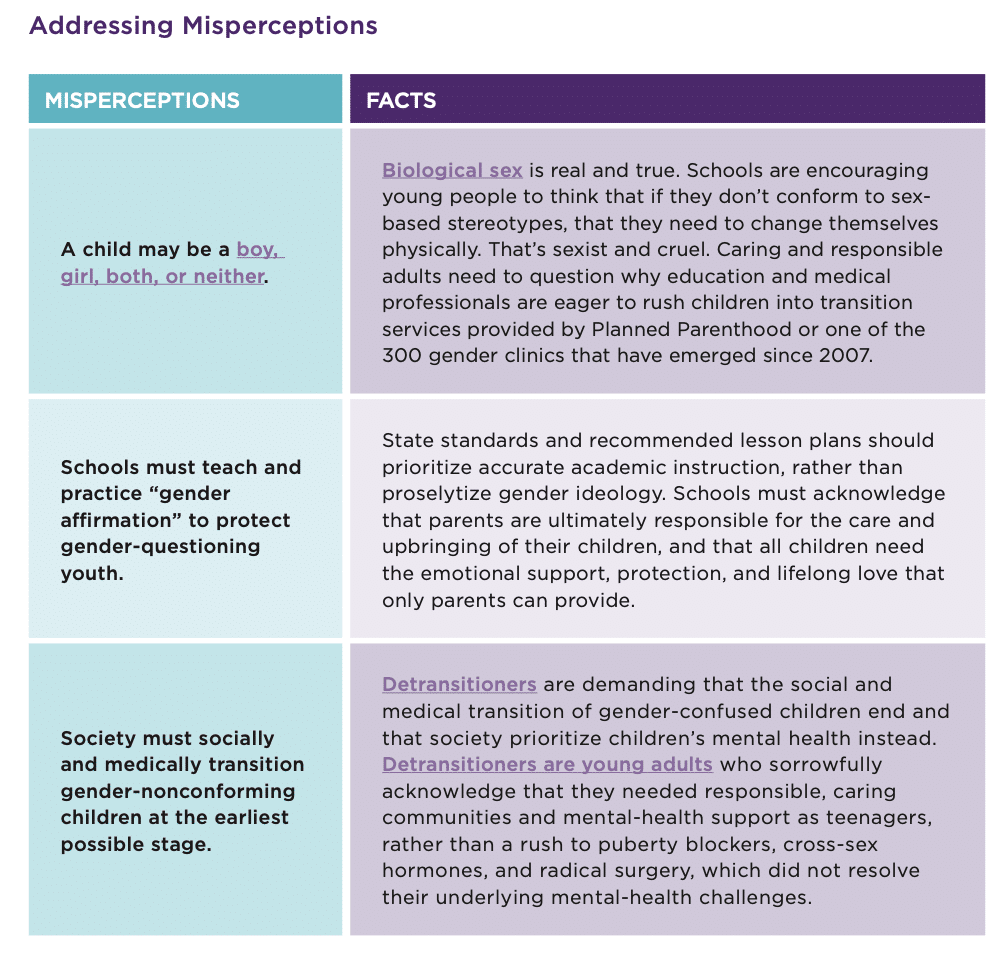*In 60 Seconds: Education Freedom
What is Education Freedom?
Education freedom funds students, not systems. Unfortunately, school districts and unions...
Resources Issue: Parenting
In 60 Seconds: Gender Ideology in Schools
- Schools tell highly sensitive children, often girls, that, regardless of their struggles with depression, anxiety, obsession rumination, or eating disorders, cutting off their breasts (“top surgery”) and a lifetime of high-risk testosterone injections (“gender-affirming care”) will bring them “trans joy.”
- Public school policies punish school staff, students, and parents who do not adhere to this radical belief system.
- Activist-drafted policies require schools to transition children and then hide their new names, identities, and pronouns from parents through “Gender Support Plans.”
- These plans are based on the radical assumption that the only option is an immediate and unquestioning affirmation of a new identity.
- Florida’s Parental Rights in Education law ensures that young students are not exposed to gender ideology lessons.
- The Virginia Department of Education’s revised “model policies” involve parents if a child requests a name and pronoun change.

How To: Improve Your Community’s School System
Parents are increasingly concerned about their children’s schools. From Common Core math, declining literacy requirements, and flat out a-historical history and civics lessons to damaging critical race theories, restorative justice discipline practices, and social justice political activism on the part of teachers and school administrators, it seems that traditional learning is a thing of the past.
Parents are tired of this situation. But what can they do? Where can they go?
In this guide, we hope to help parents engage with teachers and teaching staff, school officials, other parents, and the local community. From simply talking to your child’s teacher to running for office, this guide will help you help your child gain a better education.
Engage with Teachers
Sometimes it can be as simple as calling, emailing, or meeting face-to-face with your child’s teacher. There are some exceptions, but most teachers want parents’ input and to make parents a part of their child’s learning process. Communication shouldn’t be a one-way street. Just like your child’s teacher provides a report card on your child’s educational progress, you should feel free to give feedback to the teacher about what your child is learning.
Here are some ideas for engaging with your child’s school.
- If your child is in elementary school, talk to the teacher when the children are dismissed. Usually teachers stand outside the school with their class until they are loaded onto a bus or picked up by a parent or caregiver. This is the perfect time to casually approach a teacher and ask questions about the class or curriculum.
- Write an email to the teacher. Sometimes it’s nice to give a teacher some time to consider the note and write a response. Writing a note that is friendly, polite, and inquisitive is a good first step to getting information.
- Ask to talk by phone. If the issue is complex or if it’s simply easier to talk by phone, write an email to the teacher asking to make an appointment to speak by phone. It’s nice to give the teacher an option of choosing the best time to talk.
- Ask for a face-to-face meeting. Sometimes it’s best to just sit down and chat face-to-face, especially if the issue is hard to discuss or involves your child’s wellbeing. Sometimes it’s nice to offer to bring the teacher coffee (since they can’t leave the building during the day to run to the coffee shop). This is a nice gesture that can often help break the ice before delving into the issue that concerns you.
Ask for the Curriculum, Read It, and Ask for Changes!
- First, ASK! You have a right to see your child’s curriculum. And it’s critically important to know what your child is being taught. Too often, parents are shocked to learn—months into the school year—that their children are learning things that are contrary to their family’s religious or personal beliefs, or that seem to contradict facts. The best way to avoid this situation is to ask your child’s teacher for a complete copy of the curriculum (these are usually posted online so it is not a hassle for a teacher to simply email you the curriculum) at the beginning of the school year as well as any information on assignments, class projects, and other material the children will be assigned. But that isn’t enough. Throughout the year, parents should be asking for additions or changes to the curriculum. And you should also ask if your teacher plans to go off plan with any additional assignments.
- Second, READ! It doesn’t do you any good to get the curriculum if you don’t read it and highlight areas of concern. Look for words and phrases that might indicate a political message or a lesson that runs contrary to your family’s belief system. Make sure to research the books and authors listed. If you don’t recognize the names or book tiles, use the internet to research them. Also, be sure to review the fiction books your child will be assigned to read.
- Third, PUSH for changes! If you’re concerned about your school’s curriculum, speak up. Talk first to the teacher and then to the school principal. Point out what’s of concern, be prepared to give reasons for asking for the changes, and make suggestions for improvements. If your school is integrating Critical Race Theory into the curriculum, suggest the school use the historically-accurate 1776 Curriculum as an alternative.
- Fourth, speak to other parents! Ask to speak at a PTA meeting about the curriculum. This can be scary but it’s likely other parents are concerned as well. Simply speaking in calm and measured tones about your concerns at a PTA meeting will help alert parents who are unaware. You might even find allies who are interested in joining you in complaining to the school administration or school board.
- Pick your battles! You lose credibility if you object to everything and nitpick about minor issues. Focus on the most egregious and sweeping areas of concern.
- It’s your right! The Family Educational Rights and Privacy Act (FERPA), which passed in 1974, gives parents the right to inspect their child’s educational records and the curriculum.
Opt Out! Take Your Child Out of School Programs
You are the parent! You are ultimately in charge of your child’s education. If, after reading the curriculum and attempting to make changes, you still aren’t comfortable with what’s being taught, opt your child out of that particular program. Specifically, the law protects parents’ rights to opt their children out of sex education classes and standardized tests. The Every Student Succeeds Act allows parents to refuse testing for their children.
Join Your PTA and Take a Leadership Role
Sadly, PTAs are not always reliable for helping parents deal with school officials. That’s why it’s important to get involved and to try to seek a leadership position within the PTA. PTA policies are often driven by its leadership, so get in there and lead! It’s important to be prepared to volunteer a lot of personal time. PTAs need parent volunteers and the way to get a leadership position is to show you care about the school and students. Volunteering will help you learn more about the school and the student population, parents’ concerns, the schools’ philosophy, and teacher and administration goals. You are likely to find allies and even friends! Once in a leadership position, you’ll be better situated to make changes and steer your school toward educational efforts over political activism.
That said, it’s important to know that the national PTA organization is closely aligned with teachers’ unions. In addition, the National PTA organization pushes exclusively left-wing and social justice causes—gun control, higher taxes, environmental regulations, allowing boys in girls’ bathrooms, pushing for critical race theory to be taught in schools, as well as opposing school choice. Not all local PTAs espouse these political ideologies or back these political issues, but the national PTA organization pushes politics instead of standing up for parents and children.
Meet the Superintendent, School Board Members and School Principals
In many school districts, the superintendent and other school officials host regular “coffee meetings” with parents and caregivers. This is a great opportunity to introduce yourself and tell the school officials a little bit about your child and your interest in being an active member of the school community. Regular attendance at these meetings will make you a familiar face, and they might be more willing to listen to you once you’ve established a personal, working relationship with them.
Run for School Board or Another Public Office
That may sound scary but, as a parent, you’re the perfect person to represent other parents and the concerns they have about the public schools. A first step on this journey might be working with the PTA. This will help you meet more parents, get to know the school administration, and learn leadership skills along the way.
Speak Up on Social Media and on Neighborhood Listservs
A good way to share information and to find allies is by using social media platforms, like Facebook, Twitter, and Instagram (see these guides—here, here, here, and here—for more information on these social media platforms). Local communities and even some neighborhoods also have listservs, which are groups dedicated to issues that affect a particular area or community. Depending on the rules of your community’s listservs (some don’t allow political discussions), this might be a good place to post your concerns and engage in polite and civil conversation about issues affecting your community and local school district.
Start a Facebook Group Dedicated to School Reform
Facebook has a feature where you can start a group to promote a particular issue or cause. This is an excellent tool to use for local engagement and community activism.
- Don’t like the curriculum your public school is using? Start a “Parents Take Back The Curriculum” group.
- Concerned about Critical Race Theory being taught in your public school? Start a “Parents Against Critical Race Theory” group.
- Worried about the content of your school’s sex education courses? Start a “Sex Education Parent Information Coalition” group.
This is an excellent way to organize a grassroots group, find like-minded people, take polls and surveys, and get the attention of local media. For more information on starting a Facebook group, see the How To Engage on Facebook document.
Engage Local Media
State and local papers are often looking for content, especially from the perspective of locals. Share your perspective, experiences, and personal views. See the How to Write a Letter to The Editor and the How To Write an Opinion Editorial for more information on these topics.
Letter: Opt Out of Your Child Wearing Masks
*PDF Download: Opt Out of Your Child Wearing Masks
Dear _____:
I am writing to share my thoughts on masking kids. Kids should not be forced to wear masks in school.
I know you have to make a lot of tough decisions, and you can’t please everyone. I am aware that some in the community may not agree with my perspective. I hope that our community can have an open and honest discussion about this topic, and I hope that we will make decisions based on the facts and not politics or emotion.
I’ll try to be brief but here are a few points that summarize my reasons for not supporting mandatory masks for children in schools:
- COVID doesn’t pose a serious health risk to most children. And the risks to most adults have been mitigated and have decreased.
- Students and adults in our community (teachers, school staff, parents and family members) have now had a chance to get vaccinated/boosted.
- Because many people have now had the virus, which has given them natural immunity, the risk of serious illness from infection is low.
- Effective antiviral medications are now available.
- Masking has not been shown to be effective at reducing the spread of COVID, or other respiratory viruses, in schools.
-
- The best way to determine the efficacy of a particular medical intervention is to conduct a randomized clinical trial. The gold standard for this type of scientific research is the NIH-funded Cochrane, the world’s most respected organization for this type of inquiry. It is considered “the best single resource for methodologic research” and is “recognized worldwide as the highest standard in evidence-based healthcare.”
- In January 2023, Cochrane published a thorough review of the literature on masks, including trials during the Covid-19 pandemic in hospitals and in community settings. The 15 trials compared outcomes of wearing of surgical masks versus wearing no masks, and also versus N95 masks. The review, conducted by a dozen researchers from six countries, concludes that wearing any kind of face covering “probably makes little or no difference” in reducing the spread of respiratory illness.
- Other studies have come to similar conclusions: A cluster randomized trial in Bangladesh on masking in adults (not children or schools) showed that wearing a cloth mask was not effective. In adults, widespread use of surgical masks helped reduce the spread of COVID.
- In Spain, where children 5 and under do not mask in school and children 6 and over do, researchers (in a regression discontinuity study) found no difference in the rate of spread between 5 year olds and 6 year olds.
- You may have seen some studies showing an association between school mask mandates and lower pediatric cases of COVID. Many of these studies are seriously flawed because they do not correct for other factors, like vaccination rates, testing rates, general population health, and other COVID precautions. It is difficult, in observational studies like these, to isolate or demonstrate the effect of mask mandates.
- The burden of proof that masking works lies with those who would seek to mandate masking. This is the case with any intervention.
- We know about the significant downsides of mask-wearing for children.
- Masking kids is associated with: increases in anxiety and depression; decreases in communication and socialization skill development; increases in headaches, face rashes and redness, and impaired facial recognition; and increases in tooth decay. We also now know that masks can be detrimental to babies’ speech and language development.
- Another study has shown that masking reduces intelligibility and recall for listeners. This has to have implications for educational settings.
- The impact of masking on schoolchildren merits more study. In the absence of more information, this judgment call should be left up to parents, who know best how masking might affect their child. If parents want their child to wear a mask, the school should allow it. But the educational cost of face coverings is far better established than the benefits of mandates.
- The rest of the world (outside of the U.S.) seems to understand that masks on kids are not a good idea.
- The World Health Organization has held since August 2020 that no one under the age of 5 should be required to wear a mask. European countries, like the U.K. and France, did not require masks on young children even in school settings, even at the height of the pandemic.
- From this article: “It’s important that primary schoolchildren don’t wear face coverings,” says Public Health England’s medical adviser Dr. Susan Hopkins. She explains that this is because COVID poses a low risk to children and that wearing face coverings “could affect their development.”
Below are some links to more articles that expand on some of these points and more.
Article on the new Cochrane Study
The Downsides of Masking Young Children are Real
I’m a Doctor. Here’s Why My Kids Won’t Wear Masks This School Year
Let my children take off their masks, the science says it is safe
Mandatory Masking of School Children is a Bad Idea
Young kids are at low COVID risk in schools, but masking them could do long-term damage
Masking children: What does the science say?
It’s 98 Degrees Out. Why Is My Child Wearing a Mask?
Thanks for reading this email and considering these facts. Of course, the COVID pandemic required many changes to our lives for some time. And I know many people lost their lives to COVID, and many people’s fears of illness persist.
I also understand and feel the continued concern about sickness in school. I too want my children to stay healthy so that they can learn and continue to attend school!
But masks on schoolchildren – especially at this point – are, in my view, more harmful than beneficial. As a parent, I can’t ignore this. I hope you understand; I have to speak up for what is best for my kids. Thanks for considering my perspective! I am happy to talk more.
Best,
NAME





